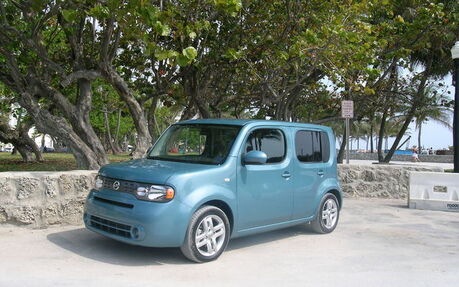2009 Nissan cube, breaking the mould!
In a time when vehicles often share elements and look alike, some people are particularly partial to out-of-the-ordinary lines. Unique personality and unusual style have become prized characteristics, and thus vehicle design is a great way to garner attention. While consumers have a range of unique vehicles to choose from, very few vehicles with remarkable looks are affordable. Indeed, not everyone can afford a super-vehicle that speaks exclusivity and recognition.
As part of this growing trend, the 2009 Nissan cube responds to the need for individuality. As the name suggests, the cube (yes, it’s written in lowercase in reference to the object rather than a proper noun) looks like a square box on four wheels. This look was spurred by the Scion xB, which should grace the Canadian market in 2010. Presently in Canada, we can compare the Nissan cube (despite its more generous dimensions) to the Honda Element, though its most direct competition is undoubtedly the Kia Soul. Just introduced, the Soul offers a similar style. It seems as though the little square box trend is really taking off!
A design with advantages
The cube’s main selling point is most definitely its style, and Nissan has not cut a single corner in that department. You either love it or you hate it. One way or the other,it won’t leave you indifferent. Its looks, like some of the colour options, will definitely command a certain amount of attention. In fact, when we took it for a test drive, we noticed several people snapping shots of it as we rolled by. This kind of attention is highly unusual for a vehicle whose starting price should be under $20,000.
With rather Cartesian lines, the cube nonetheless features some round edges – such as the corners of its large windows – to help break the lines somewhat. According to the manufacturer, the front end design was inspired by a bulldog, and thus offers an intimidating style. Meanwhile, the rear conveys different styles on either side because of an asymmetrical design marked, most notably, by a back window that wraps around the right side of the vehicle and a single pillar on the left side. The very tall cube seems to stretch right down to the ground, while a nearly non-existent frame overhang adds to its boxy looks.
Inside, the cube is markedly different than other Nissan products (despite having a few of the annoying features found on other models, such as tacky-looking hard plastics). Aside from that, however, the overall spaciousness is remarkable, with both the design and large windows contributing to excellent visibility. As a result, you don’t feel closed in, and it’s hard to believe you’re behind the wheel of such a small vehicle. And that, in sum, is the advantage of a square design!
The modern instrumentation offers some nice touches, particularly its range of colours. Most of the controls are contained in a circular area in the centre of the dashboard, with the sound system just above. It has to be said that, despite their efforts, the sound quality this system offers is not the best. It’s heavy and the distortion increases fairly rapidly. Music lovers are best off with the optional system.
Another one of the cube’s key design themes is a ripple-effect inspired by a drop of water falling into a puddle. On the roof, around the ceiling light, at the bottom of the cup holders, on the speakers . . . you’ll find this look just about everywhere inside the vehicle, adding a nice touch to the design. In the back, a large door gives access to the cargo space, which, despite the fact that it’s not the most spacious around, is sufficiently deep to fit sizeable objects. However, although the back seats fold down to increase the storage capacity, you can’t get a completely flat surface because these seats are fixed in place – not as practical as it could be.
A familiar vehicle
Offered in the S and SL versions, the cube is equipped with well-known components. In fact, it is built on the same platform as Nissan’s compact cars, adopted most notably for the Versa. It also comes with the Versa’s 1.8-litre 122-hp four-cylinder engine, which is paired with either a six-speed manual transmission or a continuous variable transmission (CVT). Essentially, the cube is a stylized Versa with slightly bigger dimensions.
I must admit that I wasn’t expecting to be impressed by its handling. It’s obvious that the manufacturer’s main focus was the vehicle’s style, so I expected it to handle like a sub-compact car, only in a heavier and taller body. And yet, our road test revealed a pleasant surprise. Thanks to the generous 127 lb.-ft. of torque, the four-cylinder engine proved lively and produced some good accelerations (a feeling that was supported by a fast-reacting accelerator). The CVT also performed well, despite my reserves about this type of transmission. I’d say that Nissan has managed to make its CVT almost as pleasant as a conventional automatic, putting it ahead of Mitsubishi in this regard. What’s more, the CVT results in fuel savings, allowing the cube to clock in at an average consumption of 6.5 L/100 km. In short, the cube offers dynamic driving and is anything but anaemic. Plus, its mechanical components are much more modern than those found in its main rival the Kia Soul.
The price has not been revealed yet, but we can expect the starting price to figure around $20,000, as that would give it a fair chance against the competition. This vehicle, which can be appreciated for its lines, handling and mechanical components, goes on sale in May 2009 along with a wide range of equipment and accessories to help you make your cube more exclusive and, naturally, more expensive.
